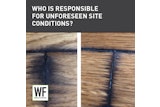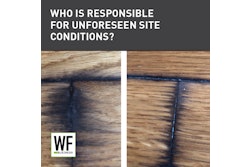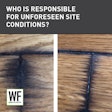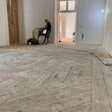Barry was typically cautious when working with the chop saw, but one day, while rushing to finish racking out a floor, the unfortunate happened and Barry ended up being driven to the hospital with his index finger packed on ice. Rob, the owner of the company, feels terrible about Barry's injury, but he's also worried: Will this accident cost him? How much?
Many state workers compensation laws were originally passed a century ago and were designed to provide injured workers with medical and financial benefits regardless of fault after a workplace accident. These laws also protected employers, because employees could only collect via workers comp rather than filing other suits. Today, however, serious workplace accidents may also subject employers to a variety of civil—and in some instances even criminal—liability. Following are ways to minimize employer liability for workplace accidents.
Get a Game Plan
The best time to address the consequences of a serious workplace accident is before one occurs. Employers must develop comprehensive safety programs that combine written work rules that are strictly enforced, mandate regular safety inspections and safety meetings to provide ongoing training to employees on safety issues, and conduct post-accident drug testing. (For more on drug testing, see "Passing the Test" in the February/March 2007 issue of Hardwood Floors.) It is critical for employers to document all of their efforts to ensure a safe workplace for their employees. For example, new employees must be provided with a copy of the employer's safety handbook and be required to acknowledge in writing that they have read and understand their obligations under the employer's safety program. Employees should sign a form acknowledging their attendance at mandatory safety training, and, ideally, each formal safety training program should conclude with a brief written test on the materials covered. Finally, employers must consistently enforce their safety program and discipline workers when necessary.
While each employer should have a comprehensive safety handbook, the issue of safety should also be included in the general employee handbook. Safety should become second nature for all employees regardless of their position within the business. This requires the strong support of management. If employees believe that management does not care if they are injured at work and that safety can be sacrificed for increased production, then accidents are not only more likely to occur, but are also likely to involve serious injury.
While specific types of safety issues can differ based on the type of business, some safety issues are common to all businesses. For example, every employer must have procedures to address hazardous materials, first aid, fire, blood-borne pathogens and lifting techniques. Hardwood flooring contractors must also have safety procedures designed to address eye protection; respirators; hearing protection; proper use of saws, sanders and other power tools; and electrical and fire safety.
As an incentive, many companies have established award systems for working safely. For example, crews that go without a lost-time accident for a certain time period may be rewarded with a company barbeque, time off or other incentives.
After the Fact
When a workplace accident occurs, an employer's first concern should be to get the injured employee appropriate medical treatment. Afterward, when an employee has been granted workers comp, some claims seem to take on a life of their own. This occurs either through inattention on the part of the employer or aggressive "lawyering" on the part of the injured employee's counsel. It is critical for employers to manage their workers comp claims so injured employees receive the benefits they deserve, but do not receive benefits for conditions unrelated to their workplace injury.
After a serious workplace accident occurs, employers must be prepared for unwanted attention from the media, investigations from local and/or state public safety authorities and OSHA, as well as questions from the injured employee and his family. Out of fear of admitting liability, many employers shirk their moral obligation to an injured employee and avoid direct contact with him because they are concerned that anything they say or do will be used by an attorney to establish the company's liability for the workplace accident. Employers should resist this fear and feel free to express their genuine concern for the injured employee's wellbeing.
Get Legal Help
If the workplace accident is serious enough, OSHA citations and penalties are a virtual certainty. OSHA citations are characterized as "repeat or willful violations," "serious violations" or "other-than-serious violations." After a serious workplace accident, a lawyer who practices in this area should immediately be consulted to guide the employer through OSHA's investigation and citation-issuing process. Interestingly, a decision not to issue a citation is often based on factors outside of federal regulations, such as whether the employer's work rules are consistently enforced, whether management is involved in the planning and administration of the employer's safety program, and whether or not safety consulting and related trade groups are effectively utilized by the employer.
In addition to federal regulations under OSHA, most states have their own safety codes that employers must be familiar with. Multi-state employers should review the laws of the various states in which they operate.
The time to act is now to minimize any future liability for your business. Preventing accidents decreases not only your potential liability, but also your costs for workers comp and related claims. More importantly, it will keep your business out of the headlines and keep your employees safe.
































